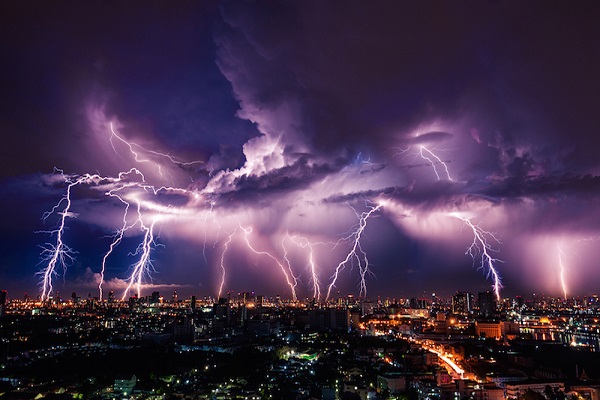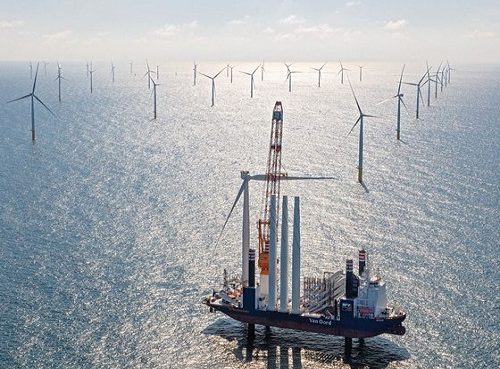When a storm’s charging zone sits close to the Earth’s surface, the resulting “superbolts” can be 1,000 times stronger than regular lightning.
Superbolts are more likely to strike the closer a storm cloud’s electrical charging zone is to the land or ocean’s surface, a new study finds. These conditions are responsible for superbolt “hotspots” above some oceans and tall mountains.
Superbolts make up less than 1% of total lightning, but when they do strike, they pack a powerful punch. While the average lightning strike contains around 300 million volts, superbolts are 1,000 times stronger and can cause major damage to infrastructure and ships, the authors say.
“Superbolts, even though they’re only a very, very tiny percentage of all lightning, they’re a magnificent phenomenon,” said Avichay Efraim, a physicist at the Hebrew University of Jerusalem and lead author of this study.
A 2019 report found that superbolts tend to cluster over the Northeast Atlantic Ocean, the Mediterranean Sea and the Altiplano in Peru and Bolivia, which is one of the tallest plateaus on Earth. “We wanted to know what makes these powerful superbolts more likely to form in some places as opposed to others,” Efraim said.
The new study provides the first explanation for the formation and distribution of superbolts over land and sea worldwide. The research was published in the Journal of Geophysical Research: Atmospheres, AGU’s journal dedicated to advancing the understanding of Earth’s atmosphere and its interaction with other components of the Earth system.
Storm clouds often reach 12 to 18 kilometers (7.5 to 11 miles) in height, spanning a wide range of temperatures. But for lightning to form, a cloud must straddle the line where the air temperature reaches 0 degrees Celsius (32 degrees Fahrenheit). Above the freezing line, in the upper reaches of the cloud, electrification takes place and generates the lightning’s “charging zone.” Efraim wondered whether changes in freezing line altitude, and subsequently charging zone height, could influence a storm’s ability to form superbolts.
Past studies have explored whether superbolt strength could be affected by sea spray, shipping lane emissions, ocean salinity or even desert dust, but those studies were limited to regional bodies of water and could explain at most only part of the regional distribution of superbolts. A global explanation of superbolt hotspots remained elusive.
To determine what causes superbolts to cluster over certain areas, Efraim and his co-authors needed to know the time, location and energy of select lightning strikes, which they obtained from a set of radio wave detectors. They used these lightning data to extract key properties from the storms’ environments, including land and water surface height, charging zone height, cloud top and base temperatures, and aerosol concentrations. They then looked for correlations between each of these factors and superbolt strength, gleaning insights into what causes stronger lightning — and what doesn’t.
The researchers found that contrary to previous studies, aerosols did not have a significant effect on superbolt strength. Instead, a smaller distance between the charging zone and land or water surface led to significantly more energized lightning. Storms close to the surface allow higher-energy bolts to form because, generally, a shorter distance means less electrical resistance and therefore a higher current. And a higher current means stronger lightning bolts.
The three regions that experience the most superbolts — the Northeast Atlantic Ocean, the Mediterranean Sea and the Altiplano — all have one thing in common: short gaps between lightning charging zones and surfaces.
“The correlation we saw was very clear and significant, and it was very thrilling to see that it occurs in the three regions,” Efraim said. “This is a major breakthrough for us.”
Knowing that a short distance between a surface and a cloud’s charging zone leads to more superbolts will help scientists determine how changes in climate could affect the occurrence of superbolt lightning in the future. Warmer temperatures could cause an increase in weaker lightning, but more moisture in the atmosphere could counteract that, Efraim said. There is no definitive answer yet.
Moving forward, the team plans on exploring other factors that could contribute to superbolt formation, such as the magnetic field or changes in the solar cycle.
“There is much more unknown, but what we’ve found out here is a big piece of the puzzle,” Efraim said. “And we’re not done yet. There’s much more to do.”
Source: eurekalert










